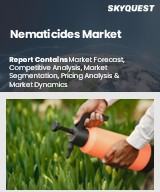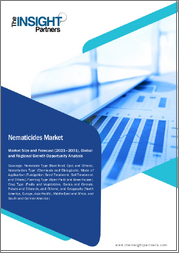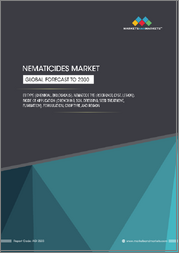
|
시장보고서
상품코드
1796471
살선충제 시장 규모, 점유율, 성장 분석 : 유형별, 작물별, 제제별, 선충 유형별, 적용 모드별, 지역별 - 산업 예측(2025-2032년)Nematicides Market Size, Share, and Growth Analysis, By Type (Chemical, Biological), By Crop (Vegetables, Field Crops), By Formulation, By Nematode Type, By Application Mode, By Region - Industry Forecast 2025-2032 |
||||||
세계 살선충제 시장 규모는 2023년에 28억 달러로 평가되었으며, 예측 기간(2025-2032년) 동안 CAGR 8.1%로, 2024년 30억 3,000만 달러에서 2032년에는 56억 4,000만 달러로 성장할 전망입니다.
세계 살선충제 시장은 고부가가치 작물에 대한 수요 증가와 선충의 확산으로 인해 강력한 성장세를 보이고 있습니다. 지속가능한 농업으로의 전환은 이러한 확대에 박차를 가하고 있으며, 바이오 기반 살선충제 및 종합적 해충 관리(IPM) 전략에 대한 관심이 증가하고 있습니다. 농지가 확대되고 화학농약에 대한 규제가 강화됨에 따라 농부들은 보다 안전하고 친환경적인 살선충제 대안을 찾고 있습니다. 아시아태평양은 농업 부문의 중요한 성장 지역으로 부각되고 있으며, 시장 잠재력을 더욱 높이고 있습니다. 제형 기술의 혁신과 효과적인 작물 보호 방법에 대한 인식의 향상도 시장 발전에 기여하고 있으며, 이는 궁극적으로 수확량 향상과 건강한 토양을 만드는 데 기여하고 있습니다.
목차
소개
- 조사 목적
- 조사 범위
- 정의
조사 방법
- 정보 조달
- 2차와 1차 데이터 방법
- 시장 규모 예측
- 시장 가정과 제한
주요 요약
- 세계 시장 전망
- 공급과 수요 동향 분석
- 부문별 기회 분석
시장 역학과 전망
- 시장 개요
- 시장 규모
- 시장 역학
- 성장 촉진요인과 기회
- 성장 억제요인과 과제
- Porters 분석
주요 시장 인사이트
- 핵심성공요인
- 경쟁 정도
- 주요 투자 기회
- 시장 생태계
- 시장 매력 지수(2024년)
- PESTEL 분석
- 거시경제 지표
- 밸류체인 분석
- 가격 분석
살선충제 시장 규모 : 유형별 & CAGR(2025-2032년)
- 시장 개요
- 화학제품
- 훈증제
- 유기인 화합물
- 카바메이트
- 기타 유형(아세토프롤, 벤클로티아즈, DBCP, 키토산)
- 생물학적
- 미생물
- 생화학적
- 거대생물
살선충제 시장 규모 : 작물별 & CAGR(2025-2032년)
- 시장 개요
- 채소
- 밭작물
- 과일
- 기타
살선충제 시장 규모 : 제제별 & CAGR(2025-2032년)
- 시장 개요
- 입상
- 액체
- 기타 제제
살선충제 시장 규모 : 선충 유형별 & CAGR(2025-2032년)
- 시장 개요
- 뿌리혹선충
- 낭종선충
- 병변선충
- 기타 선충 유형(스터비-루트선충 및 줄기선충)
살선충제 시장 규모 : 적용 모드별 & CAGR(2025-2032년)
- 시장 개요
- 화학 관류
- 엽면 살포
- 훈증
- 종자 처리
- 토양 처리
살선충제 시장 규모 & CAGR(2025-2032년)
- 북미
- 미국
- 캐나다
- 유럽
- 독일
- 스페인
- 프랑스
- 영국
- 이탈리아
- 기타 유럽
- 아시아태평양
- 중국
- 인도
- 일본
- 한국
- 기타 아시아태평양
- 라틴아메리카
- 브라질
- 기타 라틴아메리카
- 중동 및 아프리카
- GCC 국가
- 남아프리카공화국
- 기타 중동 및 아프리카
경쟁 정보
- 상위 5개사의 비교
- 주요 기업의 시장 포지셔닝(2024년)
- 주요 시장 기업이 채용한 전략
- 최근의 시장 동향
- 기업의 시장 점유율 분석(2024년)
- 주요 기업 개요
- 기업 상세
- 제품 포트폴리오 분석
- 기업 부문별 점유율 분석
- 매출 전년비 비교(2022-2024년)
주요 기업 개요
- BASF SE(Germany)
- Bayer AG(Germany)
- Syngenta AG(Switzerland)
- UPL Limited(India)
- Corteva Agriscience(U.S.)
- FMC Corporation(U.S.)
- American Vanguard Corporation(U.S.)
- Nufarm(Australia)
- ADAMA Agricultural Solutions Ltd.(Israel)
- Valent BioSciences LLC(U.S.)
- Certis Biologicals(U.S.)
- Ishihara Sangyo Kaisha Ltd.(ISK)(Japan)
- Sumitomo Chemical Co., Ltd.(Japan)
- Marrone Bio Innovations(U.S.)
- Simbiose Agrotecnologia Biologica(Brazil)
- Profarm(U.S.)
- Isagro S.p.A(Italy)
- Chr. Hansen(Denmark)
- Vive Crop Protection(Canada)
- Albaugh LLC(U.S.)
결론과 제안
KSM 25.09.03Global Nematicides Market size was valued at USD 2.8 billion in 2023 and is poised to grow from USD 3.03 billion in 2024 to USD 5.64 billion by 2032, growing at a CAGR of 8.1% during the forecast period (2025-2032).
The global nematicides market is experiencing robust growth driven by rising demand for high-value crops and increasing incidences of nematode infestations. The shift towards sustainable agricultural practices is fueling this expansion, with heightened interest in bio-based nematicides and integrated pest management (IPM) strategies. As farmland expands and restrictions on chemical pesticides intensify, farmers are seeking safer, environmentally friendly nematicide alternatives. The Asia-Pacific region stands out as a significant growth area in the agricultural sector, further boosting market potential. Innovations in formulation technologies, along with enhanced awareness of effective crop protection methods, are also contributing to the market's advancement, ultimately leading to improved yields and the promotion of healthier soil practices.
Top-down and bottom-up approaches were used to estimate and validate the size of the Global Nematicides market and to estimate the size of various other dependent submarkets. The research methodology used to estimate the market size includes the following details: The key players in the market were identified through secondary research, and their market shares in the respective regions were determined through primary and secondary research. This entire procedure includes the study of the annual and financial reports of the top market players and extensive interviews for key insights from industry leaders such as CEOs, VPs, directors, and marketing executives. All percentage shares split, and breakdowns were determined using secondary sources and verified through Primary sources. All possible parameters that affect the markets covered in this research study have been accounted for, viewed in extensive detail, verified through primary research, and analyzed to get the final quantitative and qualitative data.
Global Nematicides Market Segments Analysis
Global Nematicides Market is segmented by Type, Crop, Formulation, Nematode Type, Application Mode and region. Based on Type, the market is segmented into Chemical and Biological. Based on Crop, the market is segmented into Vegetables, Field Crops, Fruits and Others. Based on Formulation, the market is segmented into Granular, Liquid and Other Formulations. Based on Nematode Type, the market is segmented into Root-Knot Nematodes, Cyst Nematodes, Lesion Nematodes and Other Nematode Types (stubby-root nematodes and stem nematodes). Based on Application Mode, the market is segmented into Chemigation, Foliar, Fumigation, Seed Treatment and Soil Treatment. Based on region, the market is segmented into North America, Europe, Asia Pacific, Latin America and Middle East & Africa.
Driver of the Global Nematicides Market
The rising prevalence of soil-borne nematodes affecting essential crops like potatoes, soybeans, and cereals has significantly boosted the need for nematicides. This heightened demand is primarily driven by the economic repercussions of substantial yield losses that farmers face. In response to these challenges, agricultural producers are increasingly adopting both chemical and bio-based solutions to protect their crops. As a result, the market for nematicides is witnessing considerable growth, reflecting the urgent need for effective pest management strategies in modern agriculture. This trend highlights the critical role that nematicides play in safeguarding crop health and optimizing agricultural productivity.
Restraints in the Global Nematicides Market
The global nematicides market faces significant challenges due to strict environmental and safety regulations that restrict the application of pesticides. The prolonged approval process for new chemical formulations, particularly in regions like the EU and North America, results in elevated development costs, which can hinder the successful commercialization of novel products. As a consequence, these regulatory hurdles inhibit the market's capacity for growth and innovation, preventing it from reaching its full potential and limiting the availability of effective nematicide solutions for agricultural needs. Such constraints highlight the ongoing tension between regulatory compliance and market expansion.
Market Trends of the Global Nematicides Market
The Global Nematicides market is witnessing a significant shift towards sustainable practices, driven by heightened environmental awareness and stringent regulatory measures. This trend has propelled the demand for bio-based and organic nematicides, as farmers increasingly favor microbial and plant-derived solutions to meet consumer preferences for chemical-free produce. Consequently, leading manufacturers are intensifying their investments in research and development to expand their range of bio-nematicide offerings. The focus on environmentally friendly pest control solutions not only aligns with consumer demand but also benefits from government incentives, positioning the bio-nematicide segment for robust growth within the broader agricultural landscape.
Table of Contents
Introduction
- Objectives of the Study
- Scope of the Report
- Definitions
Research Methodology
- Information Procurement
- Secondary & Primary Data Methods
- Market Size Estimation
- Market Assumptions & Limitations
Executive Summary
- Global Market Outlook
- Supply & Demand Trend Analysis
- Segmental Opportunity Analysis
Market Dynamics & Outlook
- Market Overview
- Market Size
- Market Dynamics
- Drivers & Opportunities
- Restraints & Challenges
- Porters Analysis
- Competitive rivalry
- Threat of substitute
- Bargaining power of buyers
- Threat of new entrants
- Bargaining power of suppliers
Key Market Insights
- Key Success Factors
- Degree of Competition
- Top Investment Pockets
- Market Ecosystem
- Market Attractiveness Index, 2024
- PESTEL Analysis
- Macro-Economic Indicators
- Value Chain Analysis
- Pricing Analysis
Global Nematicides Market Size by Type & CAGR (2025-2032)
- Market Overview
- Chemical
- Fumigants
- Organophosphates
- Carbamates
- Other types (acetoprole, benclothiaz, DBCP, and chitosan)
- Biological
- Microbials
- Biochemical
- Macrobials
Global Nematicides Market Size by Crop & CAGR (2025-2032)
- Market Overview
- Vegetables
- Field Crops
- Fruits
- Others
Global Nematicides Market Size by Formulation & CAGR (2025-2032)
- Market Overview
- Granular
- Liquid
- Other Formulations
Global Nematicides Market Size by Nematode Type & CAGR (2025-2032)
- Market Overview
- Root-Knot Nematodes
- Cyst Nematodes
- Lesion Nematodes
- Other Nematode Types (stubby-root nematodes and stem nematodes)
Global Nematicides Market Size by Application Mode & CAGR (2025-2032)
- Market Overview
- Chemigation
- Foliar
- Fumigation
- Seed Treatment
- Soil Treatment
Global Nematicides Market Size & CAGR (2025-2032)
- North America (Type, Crop, Formulation, Nematode Type, Application Mode)
- US
- Canada
- Europe (Type, Crop, Formulation, Nematode Type, Application Mode)
- Germany
- Spain
- France
- UK
- Italy
- Rest of Europe
- Asia Pacific (Type, Crop, Formulation, Nematode Type, Application Mode)
- China
- India
- Japan
- South Korea
- Rest of Asia-Pacific
- Latin America (Type, Crop, Formulation, Nematode Type, Application Mode)
- Brazil
- Rest of Latin America
- Middle East & Africa (Type, Crop, Formulation, Nematode Type, Application Mode)
- GCC Countries
- South Africa
- Rest of Middle East & Africa
Competitive Intelligence
- Top 5 Player Comparison
- Market Positioning of Key Players, 2024
- Strategies Adopted by Key Market Players
- Recent Developments in the Market
- Company Market Share Analysis, 2024
- Company Profiles of All Key Players
- Company Details
- Product Portfolio Analysis
- Company's Segmental Share Analysis
- Revenue Y-O-Y Comparison (2022-2024)
Key Company Profiles
- BASF SE (Germany)
- Company Overview
- Business Segment Overview
- Financial Updates
- Key Developments
- Bayer AG (Germany)
- Company Overview
- Business Segment Overview
- Financial Updates
- Key Developments
- Syngenta AG (Switzerland)
- Company Overview
- Business Segment Overview
- Financial Updates
- Key Developments
- UPL Limited (India)
- Company Overview
- Business Segment Overview
- Financial Updates
- Key Developments
- Corteva Agriscience (U.S.)
- Company Overview
- Business Segment Overview
- Financial Updates
- Key Developments
- FMC Corporation (U.S.)
- Company Overview
- Business Segment Overview
- Financial Updates
- Key Developments
- American Vanguard Corporation (U.S.)
- Company Overview
- Business Segment Overview
- Financial Updates
- Key Developments
- Nufarm (Australia)
- Company Overview
- Business Segment Overview
- Financial Updates
- Key Developments
- ADAMA Agricultural Solutions Ltd. (Israel)
- Company Overview
- Business Segment Overview
- Financial Updates
- Key Developments
- Valent BioSciences LLC (U.S.)
- Company Overview
- Business Segment Overview
- Financial Updates
- Key Developments
- Certis Biologicals (U.S.)
- Company Overview
- Business Segment Overview
- Financial Updates
- Key Developments
- Ishihara Sangyo Kaisha Ltd. (ISK) (Japan)
- Company Overview
- Business Segment Overview
- Financial Updates
- Key Developments
- Sumitomo Chemical Co., Ltd. (Japan)
- Company Overview
- Business Segment Overview
- Financial Updates
- Key Developments
- Marrone Bio Innovations (U.S.)
- Company Overview
- Business Segment Overview
- Financial Updates
- Key Developments
- Simbiose Agrotecnologia Biologica (Brazil)
- Company Overview
- Business Segment Overview
- Financial Updates
- Key Developments
- Profarm (U.S.)
- Company Overview
- Business Segment Overview
- Financial Updates
- Key Developments
- Isagro S.p.A (Italy)
- Company Overview
- Business Segment Overview
- Financial Updates
- Key Developments
- Chr. Hansen (Denmark)
- Company Overview
- Business Segment Overview
- Financial Updates
- Key Developments
- Vive Crop Protection (Canada)
- Company Overview
- Business Segment Overview
- Financial Updates
- Key Developments
- Albaugh LLC (U.S.)
- Company Overview
- Business Segment Overview
- Financial Updates
- Key Developments



















